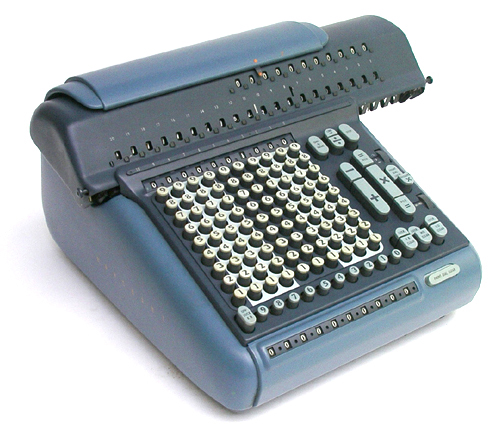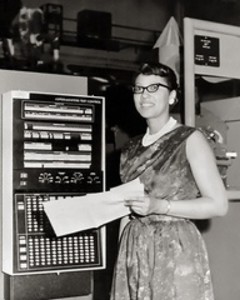I was thrilled to learn that Hollywood has decided to do a superhero movie about Katherine Johnson. What was her special power? She was a computer.

Marchant Calculator, 1950
I heard about her first a decade or so ago, when I was studying about the early days of computing and listening to Richard Feynman’s “Los Alamos From Below” talk, in which he describes rooms full of “computers” – women with Marchandt calculators. Feyman described how they would run the calculations for the trinity explosion by running cards with results around a room full of women – one doing each step. Basically it was Henry Ford’s assembly line proceses applied to math: they called it a “program.”
When the US started competing with USSR in the “space race” NASA needed computers, too. They were breaking ground already with Von Neumann’s meta-programmable computers, but that kind of brute force computing didn’t design orbits. Katherine Johnson designed that stuff:

[UPDATE: Google image search had this picture wrong and I just accepted it without checking more closely; this is Melba Mouton]

Katherine Johnson at work

Margaret Hamilton and listings
Katherine Johnson became the first of many. When people say “so-and-so opened a door” they’re talking about people like Katherine Johnson, who gently kicked open the door for other women who went to NASA and did great things. Like Margaret Hamilton, who coded the computer routine that ran Apollo 11’s onboard systems. Flawlessly. This is the real old-time hardcore coding, too – assembler, extremely tight memory constraints, magnetic cores and punch tape. The listing Margaret Hamilton is standing next to is the code for the Apollo 11. (Just to give you an idea, Microsoft Windows 10 is ~80 million lines of code, the Apollo 11 code was recently released on GitHub and is about 140,000 lines. Curiousity rover has 2.1 million lines)

Use a computer to simulate figuring it out yourself
Yay! Hollywood has decided to make one less navel-gazing remake of an 80s movie, and to do a movie about a real superhero. This is the trailer:
It looks like it’s pretty good!!
She’s just so flippin’ cool:
NASA on “when computers were humans” – interview with some other women computers:
I tried to see if there were any pictures of Katherine Johnson and Grace Hopper, but there don’t appear to be any. Too bad.
The history of women in computing is glorious. And some of them were black.


Great post! I hope the movie does her justice.
Caine@#1:
I hope the movie does her justice.
It probably can’t. Lives well-lived are hard to boil down into a couple hours of trailer-reel. Hollywood still has lots of room to screw up, but at least they won’t have explosions and 3dfx fight scenes. Except for the scene where she lectures The Hulk.
The trailer looks good.
They appear to have found a few non-white actors.
chigau@#3:
They appear to have found a few non-white actors.
Hollywood’s casting directors are getting a bit better at that.
I’d normally say something like “there’s hope” except really I think it’s that they’re looking at what cable TV is doing to them and are looking at shows like “Empire” and they’re maybe thinking they’re going to be stuck making Michael Bay movies if it’s not too late. While Hollywood keeps swinging for the summer blockbusters, cable TV is owning the bingewatch. Hollywood deserves exactly what it’s gonna get.
When I was at uni in the eighties one of our required textbooks was “FORTRAN 77 for Scientists and Engineers”, by DM Etter. I clearly remember our lecturer making a point at the time that the text of the book was very cagey about its author, never giving their full name, and he suspected that this might be because the author was a woman, and that perhaps a computer programming book would sell better if it wasn’t obviously not by a man (rather in the manner of DC Fontana (hey, that rhymed!)).
I found the book when clearing out the attic a year or two back, and googled DM Etter. Turned out she is a woman, and a startlingly accomplished one too, not least the first ever Office of Naval Research Distinguished Chair in Science and Technology. Given her involvement in the Navy’s acquisition of the F-35, though, her objective awesomeness is debatable.
somofrojblake@#5:
If she’s an old school programmer she’s probably as horrified by the state of pentagon software as the taxpayers are.
The requirements for those systems are pretty much impossible and management fad-driven (“all code must be Ada!” And realtime! And interruptable!”)
I should probably devote a posting to Margaret Hamilton too…
The photo is misidentified. It is not of Katherine Johnson, but rather of Melba Roy Mouton: https://en.wikipedia.org/wiki/Melba_Roy_Mouton
Megan Raby@#8:
The photo is misidentified
You’re right!!! Fixed and thank you.